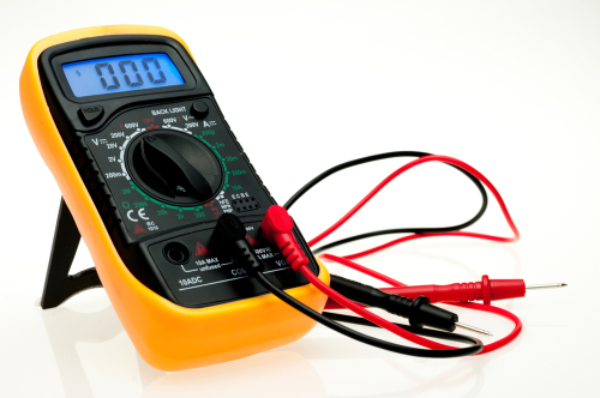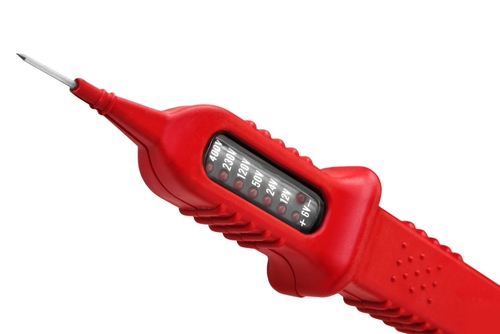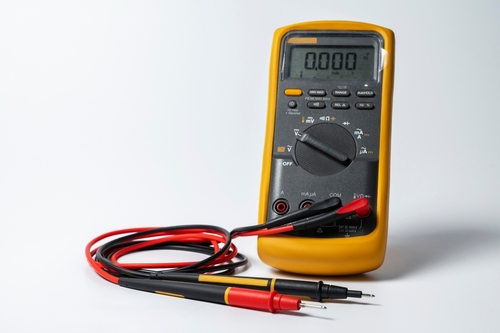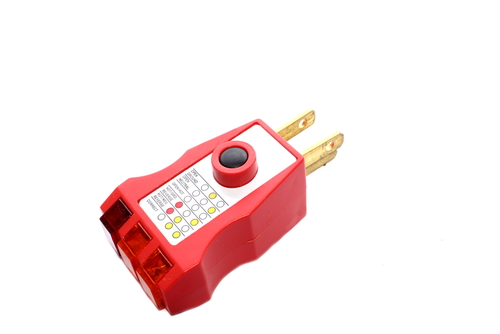
Mr. Electric explains how to safely use an electrical tester to check circuits and outlets.
|
Working on your home's electrical components is a job best left to the pros, but knowing how to use an electrical tester is one of the most empowering skills a homeowner or DIYer can have. Whether you're checking an outlet, swapping a light fixture, or just trying to figure out why that one room always trips the breaker, a trusty tester can help keep your hands (and home) safe.
In this guide, we’ll walk through the different types of testers, show you how to use a voltage tester, and explain what to look for when testing. We'll also cover how an outlet electrical tester works and when to call in a professional.
What Is an Electrical Tester?
An electrical tester is a small device used to check the presence, absence, or strength of electrical current in wires, outlets, switches, and appliances. It helps you:
- Identify live wires before working on an electrical component
- Diagnose problems in your home's wiring
- Confirm whether repairs were successful
There are several types of testers, each designed for slightly different purposes.
Types of electrical testers
Before you learn how to use electrical tester tools, it's important to choose the right type:
- Non-Contact Voltage Tester (NCVT)
- Best for: Quickly checking for live voltage
- How it works: Hold the tester near the wire or outlet; it lights up or beeps if voltage is detected.
- Pros: No need to touch wires, compact, easy to use
- Outlet Electrical Tester
- Best for: Diagnosing outlet wiring issues
- How it works: Plug it into an outlet; lights indicate correct wiring or identify problems (open ground, reversed polarity, etc.).
- Pros: Very user-friendly
- Multimeter
- Best for: Measuring voltage, current, and resistance
- How it works: Two probes are connected to the circuit and the screen shows a precise voltage reading.
- Pros: Versatile and accurate
- Continuity Tester
- Best for: Checking whether two points are electrically connected
- How it works: If the circuit is complete, the tester beeps or lights up.
- Pros: Useful for appliance repair and checking fuses
How to Use a Non-Contact Voltage Tester

Knowing how to use a voltage tester is essential for anyone doing light electrical work at home. Non-contact voltage testers (NCVTs) use beeping and warning lights to indicate that an electrical component has live power running to it. Outlets, lights, electrical wires, and light switches are all things you can test with a non-contact voltage tester.
⚠️Pro Tip: Always test on a known live source before and after testing your work. This ensures your tester is functioning properly.
Here’s how to safely test for live wires:
- Access the breaker box and turn off power to the circuit.
- Hold the tester near the component you want to test, such as an outlet receptacle or the terminals (screws) on a light switch, found beneath the faceplate. If the light glows or the unit beeps, the line is hot. This establishes that the power is off to these components.
- Once you’ve done a preliminary test, you can pull out the component and test each wire individually.
- Verify before working: Always test before you touch any wire, even if you think the breaker is off.
While NCVTs are great for basic electrical testing, they can only do so much. A non-contact tester will tell you if a component has power or not, but other tools, like multimeters, will tell you how much power it has and where the power is coming from.
How to Use a Multimeter

Using a multimeter to test an outlet is more difficult than a simple NCVT, but it provides more information, including precise voltage. This type of electrical testing is generally best left to professionals.
⚠️Pro Tip: If testing with a multimeter, hold both probes in the same hand to prevent an electrical shock from going through your body. If power is turned off at the panel box, an electrical shock shouldn’t occur, but it’s better to be safe than sorry.
Using a multimeter to test an outlet
Multimeters have many functions, but the simplest and most likely need for a homeowner is testing whether an outlet has current. Here’s how:
- Set your multimeter to the alternating current or AC function by pushing the BLACK lead into the connector labeled as COM. Push the RED lead into the other connector.
- Using one hand, insert one of the probes into each of the vertical holes on the outlet. You should receive a reading of 100 to 120 on your multimeter.
- To make sure the outlet is properly grounded, keep one of the leads in the vertical hole on the outlet. Take the other lead and insert it into the round hole. If the reading is the same as before, then your outlet is grounded correctly.
Repeat the process with the opposite probes on the outlet to make sure the wiring isn’t reversed.
How to Use a Plug-In Circuit Tester

If you simply want to verify the presence of a live circuit, you may only need a simple plug-in receptacle tester. These are easier to use non-contact voltage testers and multimeters, but have more limited applications.
- Plug the tester into the outlet.
- Read the light indicators (most testers have a guide printed on the body).
- Interpret the results:
- Two lights: Correct wiring
- One light: Open ground or neutral
- All lights: Reversed polarity
Plug-in circuit testers are perfect for diagnosing “mystery outlets” that trip GFCIs or simply don't work. They’re cheap, easy, safe to use, and incredibly helpful.
Testing GFCI Outlets with a Plug-In Circuit Tester
You can also use an outlet electrical tester to verify the functionality of Ground Fault Circuit Interrupter (GFCI) outlets. Here’s how:
- Plug in the tester.
- Check the initial light combo.
- Press the “Test” button on the GFCI outlet.
- Look for power loss on the tester.
- Hit “Reset” on the GFCI and confirm power returns.
This confirms both outlet safety and proper reset function. GFCIs save lives, so regular testing is a must.
When to Use a Tester (and When to Call a Pro)
Use an electrical tester anytime you're:
- Replacing a light switch.
- Installing a ceiling fan.
- Changing a light fixture.
- Installing or troubleshooting outlets.
- Checking if a breaker is working.
Skip the tester and call a professional if:
- You see burnt wires or outlets.
- You’re dealing with aluminum wiring.
- A breaker keeps tripping repeatedly.
- You're unsure what you're testing or how.
Trust Mr. Electric to Keep You Safe
Whether you're figuring out how to use a circuit tester, learning how to use a voltage tester, or just hoping to make sense of your breaker box, safety should always come first. If you’re not 100% sure, don’t guess.
Mr. Electric® service professionals offer safe, code-compliant electrical services with upfront, flat-rate pricing, always backed by the Neighborly Done Right Promise® to ensure your satisfaction. From voltage testing and outlet replacements to lighting upgrades and panel inspections, we’re here to help—no testing required on your part.
Contact your local Mr. Electric team today to schedule service or request an estimate.
This article is intended for general guidance only and is not applicable to every situation. You are responsible for determining the proper course of action for your property and situation. Mr. Electric is not responsible for any damages that occur as a result of advice and/or guidance derived from its blog content.
FAQs About Electrical Testers
The safety of you, your family, and your home are the top priority of every Mr. Electric service professional. Our safety-first commitment to solving your electrical issues includes meticulous attention to detail on every job. Our commitment also includes using our years of experience to answer your questions. Below are answers to some of the most frequently asked questions about how to use an electrical tester.
How do I use an electrical tester safely?
Whether you're using a multimeter, NCVT, or any other kind of electrical current checker, follow these golden rules:
- Turn off the power at the breaker box.
- Verify the tester works by testing a known live source.
- Hold the tester near the wire or outlet.
- Look or listen for indicators (lights or beeps) confirming voltage.
- Confirm there's no voltage before beginning any work.
Using an electrical tester safely is critical before working on outlets, fixtures, or appliances. Always test before touching wires, and test the tester itself to avoid false negatives.
For added protection, follow these additional safety precautions when testing electrical components:
- Never assume a wire is dead.
- Wear rubber-soled shoes and keep your hands dry.
- Use one hand to test when possible to avoid current passing through your body.
- Check your tester on a live circuit before every use.
If your gut tells you to stop, stop. Electricity isn't forgiving. When in doubt, call a professional.
What’s the difference between an outlet electrical tester and a circuit tester?
While some use these terms interchangeably, there are subtle differences:
- Outlet electrical tester: Plugs into a wall outlet and shows wiring status (e.g., reversed polarity, open ground).
- Circuit tester: Often refers to any device used to test a circuit’s voltage or continuity—this can include outlet testers or more advanced tools like multimeters.
Both help identify electrical issues, but outlet electrical testers are typically easier for beginners.
What does an electrical current checker diagnose?
An electrical current checker—often built into a multimeter—helps identify:
- Overloaded circuits
- Faulty appliances
- Inconsistent power draw
- Shorts or amperage spikes
It’s most useful for advanced users or pros. If you're unsure about the process, request an appointment with a Mr. Electric service professional for a safe and thorough evaluation.
How do you use a circuit tester to confirm safe outlet wiring?
If you're learning how to use a circuit tester, here’s a simple walkthrough:
- Plug the tester into the outlet.
- Observe the light indicators.
- Compare the light pattern to the legend on the tester:
- Two yellow lights: Correct wiring
- One yellow: Open ground
- Red + yellow: Reversed polarity
Use this test any time you replace outlets or troubleshoot non-working plugs.
What are the top DIY mistakes when testing for current?
Even the best tester can't fix human error. Here are a few rookie mistakes to avoid:
- Forgetting to turn off the breaker
- Not confirming the tester works before using it
- Touching metal probes together while live
- Using the wrong tester for the job
When in doubt, step away from the panel and contact a professional electrician.

